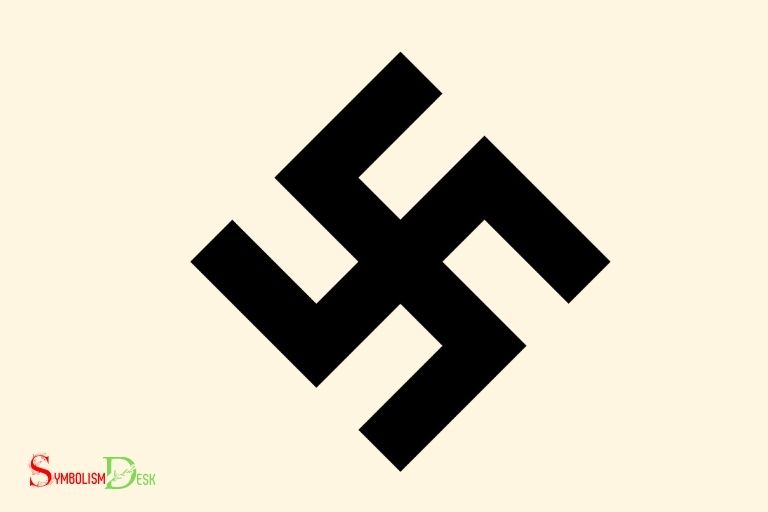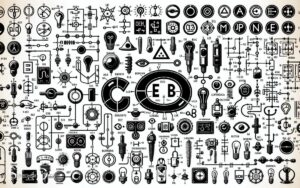What Did the Nazi Symbol Mean? The Purity of German Blood!
The Nazi symbol, also known as the swastika, represented the unification of the Aryan race, the purity of German blood, and the establishment of a totalitarian regime under Adolf Hitler’s rule.
The swastika was initially an ancient symbol associated with good fortune and well-being in several Eastern religions such as Hinduism, Buddhism, and Jainism.
However, the Nazi party adopted the swastika, rotating it 45 degrees and using it as a symbol of their political ideology, which was based on racism, nationalism, and totalitarianism. The symbol became notorious for the atrocities committed during World War II and the Holocaust.
Under Adolf Hitler’s rule, the swastika became the central symbol of the Nazi party, appearing on flags, uniforms, and official documents.
Today, the swastika is a symbol of hate and anti-Semitism, and its display is illegal in several countries, including Germany, Austria, and France.
Despite its dark history, the swastika still holds its original meaning in Eastern cultures, where it continues to be used as a symbol of good fortune and well-being.
3 Interpretation of the Nazi Symbol
| Nazi Symbol | Swastika | Meaning |
|---|---|---|
| Origin | Ancient | The swastika is an ancient symbol that predates the Nazi period and has been used by various cultures throughout history, including Hinduism, Buddhism, and Jainism. It typically represents good fortune, luck, and well-being. |
| Nazi Usage | 1920-1945 | The Nazi Party, led by Adolf Hitler, adopted the swastika as their emblem in the 1920s. They inverted and tilted the symbol, associating it with Aryan purity, nationalism, and the idea of a “master race.” |
| Contemporary Interpretation | Post-WWII | In the aftermath of World War II and the Holocaust, the swastika has become largely synonymous with the atrocities committed by the Nazis, antisemitism, and hate. It is now considered a symbol of hate and is banned or restricted in many countries. |
Key Takeaway

Five Facts About: The Nazi Symbol
History Behind The Nazi Symbol
Brief Overview Of Nazi Party And Its Symbolism
The nazi party was a far-right group that existed in germany from 1920 to 1945. The party, led by adolf hitler, was infamous for its anti-semitic beliefs and aggressive nationalist policies which eventually led to world war ii.
The nazi party had a unique symbol, a black swastika in the center of a white circle, and this symbol played a significant role in their propaganda and ideology.
Here are some key points to understand the symbol’s history behind the nazi party:
- The swastika was originally an ancient hindu symbol but was adopted by the nazi party in 1920.
- The nazi party flag was designed by hitler himself, with a red background and a white circle containing a black swastika.
- The symbol was used as both a representation of the party’s beliefs and as a way to intimidate opponents and spread fear.
- The swastika appeared on all nazi uniforms, banners, and flags.
Significance Of Designing The Swastika
The swastika played a significant role in nazi propaganda, and its design wasn’t just a coincidence.
Here’s what the design of the swastika represents:
- The swastika symbolized the concept of aryanism, the idea that the superior race of the world was of the white european descent.
- The nazi party believed that the swastika symbol was a representation of the aryans’ struggle for world domination.
- They believed it was a representation of the pursuit of happiness, freedom, and equality for all “true” germans under national socialism.
- The clockwise orientation of the swastika was considered a good omen for nazi germany’s future.
Symbolism Of The Colors Used In Nazi Flag
The swastika was not the only critical symbol used by the nazi party; the colors used in the nazi flag were also significant.
Here are some key points to understand the meanings behind the colors of the nazi flag:
- The color red symbolized the social political ideas of the nazi party – socialism.
- White color represented the nationalism and racial purity of aryanism that the nazi party believed and supported.
- Black color in this flag represented the fight against enemies of national socialism.
The history behind the nazi symbol is essential to understand how a symbol can be used for evil purposes. Although the swastika has historically been seen as a positive symbol elsewhere, the nazi party’s use of it has forever changed its interpretation.
Symbolism Of Nazi Swastika
The nazi swastika symbol is one of the most recognized and reviled symbols in modern history. To understand why the nazi regime adopted this symbol and what it meant, it is essential to delve into the symbolism of the swastika.
The Origin Of Swastika Symbol
The swastika symbol is an ancient and positive symbol with a long history. It has been found on artifacts and architecture from cultures all over the world, including the greeks, romans, celts, indians, and native americans.
The word “swastika” comes from sanskrit, and it means “well-being.
” The symbol is generally believed to represent the sun, as well as happiness, good luck, and prosperity.
Transformation Of Positive Symbol To Negative
Unfortunately, the positive association of the swastika was permanently transformed by the nazi regime.
The nazis adopted the swastika symbol in 1920, after hitler saw it during the party’s attempts to create an emblem for german workers.
They gave it a new meaning, and it became a symbol of racial superiority, aryan purity, and nazi power. This appropriation of the swastika was a perversion of its original meaning as a symbol of well-being and good fortune in many Eastern cultures. The swastika’s transformation into a hateful and destructive emblem has had lasting and damaging effects. In contrast, the halal symbol meaning holds significance as a mark of food that is permissible for Muslims to consume according to Islamic law.
For the next two decades, the swastika became synonymous with the atrocities committed by the nazis.
Contextual Significance Of Swastika In Nazi Regime
In the nazi regime, the swastika symbol was used in various ways, from the official flag and banners to propaganda materials and armbands. It became a ubiquitous symbol that represented the nazi party and its ideology.
Here are some contextual significances:
- The hakenkreuz flag, commonly known as the nazi flag, replaced the german flag after adolf hitler became chancellor in 1933. The nazi flag featured a black swastika in a white circle on a red background.
- The hitler youth, the youth organization of the nazi party, used the swastika on armbands worn by its members.
- The ss, the nazi party’s military organization, used a double lightning bolt formation with a swastika on their buttons and belt buckles.
- Concentration camps and death camps had the swastika symbol prominently displayed to send a message of terror.
The swastika symbol was a positive symbol in many cultures before the nazi regime adopted it.
The nazis transformed it into a symbol of hate and genocide, and it will forever be associated with the atrocities of world war ii.
It is a somber reminder of the evil that can come from the perversion of a once-positive symbol.
Cultural Interpretations Of The Nazi Symbol
The nazi symbol, also known as the swastika, holds a deep and complex history. Originally a sacred symbol in hinduism, buddhism, and jainism, it was adopted and twisted by the nazis to represent their ideology of aryan superiority.
However, the perception of the symbol varies widely across different cultures and religions.
Perception Of The Nazi Symbol In Different Cultures And Religions
- In hinduism, the swastika represents good fortune, prosperity, and auspiciousness.
- In buddhism, the swastika is a sacred symbol that represents the buddha’s footprints or the buddha’s heart.
- In jainism, the swastika is one of the three auspicious symbols, denoting the right path of spiritual progress.
On the other hand, the nazi symbol has become a symbol of hatred and oppression in many cultures. In western society, the swastika heavily symbolizes nazism.
Impact Of Nazi Symbolism On Contemporary Pop Culture
The nazi symbol has notably impacted contemporary pop culture in a variety of ways.
- The iconic symbol is often used in movies, video games, and books to represent nazis or antagonists that embody fascist ideologies.
- Many artists have used the nazism ideology and symbolism as inspiration in their work to make a statement against racism and discrimination.
The Controversial Legacy Of Nazi Symbolism In Today’S Society
The legacy of nazi symbolism on contemporary society is a controversial topic.
- The use of the nazi symbol is banned in many countries, and anyone who displays the symbol inherently faces social and legal consequences.
- At the same time, there is a growing debate about whether banning the nazi symbol is suppressing free speech or acknowledging the impact of hate speech on communities worldwide.
To conclude, the swastika symbol is one of the most conflicting and controversial symbols in history and modern times.
It embodies multiple cultural and religious meanings, but its adoption by the nazi party has forever linked it to negative connotations.
The Dark Side Of Nazi Symbolism
The nazi symbol, also known as the swastika, is one of the most recognizable symbols of all time. What many people don’t know is the dark history behind this infamous symbol.
In this section, we will explore the ideology of hatred behind the nazi symbol, the use of nazi symbolism in the holocaust and war crimes, and the role of nazi symbolism in modern-day hate crime.
The Ideology Of Hatred Behind The Nazi Symbol
- The swastika was adopted by the nazi party in the 1920s as a symbol of their movement.
- The nazi ideology was based on the concept of aryan supremacy, with the belief that the aryan race was superior to all other races.
- Nazis believed that jews were responsible for the majority of society’s problems and that they were a threat to the aryan race.
- Adolf hitler and the nazi party used propaganda to spread their hateful ideology, using symbols such as the swastika to create a sense of unity among their followers and instill fear in their enemies.
The Use Of Nazi Symbolism In The Holocaust And War Crimes
- The use of nazi symbolism was prevalent during the holocaust, with the swastika being displayed on uniforms, flags, and armbands worn by nazi soldiers and officers.
- The nazi party’s ideology led to the systematic murder of six million jews and other minorities in what is now known as the holocaust.
- The swastika was also used in concentration camp hierarchies, with those considered the “lowest” being labeled with the symbol.
- The use of nazi symbolism continued during world war ii, with the swastika appearing on tanks, airplanes, and other military equipment.
The Role Of Nazi Symbolism In Modern-Day Hate Crime
- Today, the nazi symbol is used by white supremacist and neo-nazi groups to promote their message of hate.
- These groups use the swastika to create fear and intimidate those who they perceive as different, including people of color and members of the lgbtq+ community.
- The use of nazi symbolism in modern-day hate crime is a reminder of the dark history behind this symbol and the importance of standing up against hate in all its forms.
The nazi symbol represents one of the darkest periods in history, a time of hatred and genocide.
By understanding the history behind this infamous symbol, we can work towards building a more peaceful and tolerant world.
FAQ About What Did The Nazi Symbol Mean
What Does The Nazi Symbol Represent?
The nazi symbol, also known as the swastika, represents the ideology of the nazi party which promoted german pride and aryan supremacy.
Was The Nazi Symbol Always A Symbol Of Hate?
No, the swastika was originally a symbol of peace and good luck in many cultures, including hinduism and buddhism.
Why Did The Nazi Party Adopt The Swastika Symbol?
The nazi party adopted the swastika symbol because they believed it represented aryan purity and power, which they sought to promote and glorify.
What Is The Significance Of The Colors In The Nazi Symbol?
The black swastika represented the dark past of germany, the white circle represented hope for a new era, and the red background symbolized the bloodshed of the nazi movement.
Is It Illegal To Display The Nazi Symbol?
In many countries, including germany, it is illegal to display the nazi symbol due to the hateful and violent actions associated with its use during the nazi regime.
Conclusion
It is vital to acknowledge that the nazi symbol, which consisted of the swastika, holds deep-rooted historical significance that remains controversial and disturbing to this day.
The symbol was initially thought to represent purity, strength, and good luck, but the atrocities committed during world war ii have rendered it synonymous with terror and oppression.
The nazi regime embraced the swastika as their official emblem, including it in all their propaganda, flags, and other materials, using it to spread their ideology of white supremacy and antisemitism.
Although the swastika has been used in various cultures and religions for thousands of years, the nazi adaptation has stripped it of its original meaning, leaving a lasting impact on humanity.
As civilization moves forward, we must remember the horrors of the past and continue to educate ourselves, ensuring that such atrocities are never repeated.





